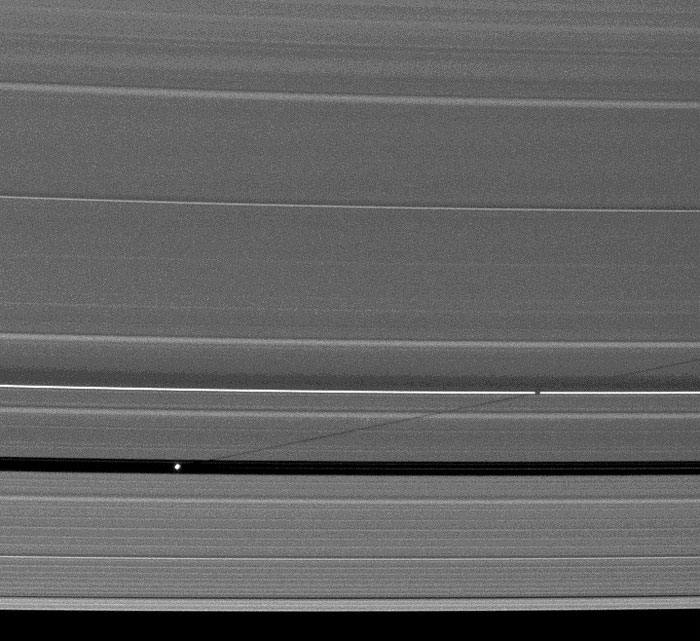-

A large crater can be seen in the southern hemisphere of Saturn's two-tone moon Iapetus.
Lit terrain seen here is on the trailing hemisphere of Iapetus (914 miles, 1471 kilometers across), a moon whose leading hemisphere is extremely dark and whose trailing hemisphere is as white as snow. This view is looking toward the south polar region of the moon located near the bottom of the image in the unilluminated area immediately to the left of the terminator.
A dark region on the moon can be seen at the top of this view. See PIA11690 and PIA12604 to learn more about Iapetus' color dichotomy.
The image was taken in visible light with the Cassini spacecraft narrow-angle camera on July 13, 2012. The view was acquired at a distance of approximately 1.2 million miles (2 million kilometers) from Iapetus and at a Sun-Iapetus-spacecraft, or phase, angle of 93 degrees. Scale in the original image was 7 miles (12 kilometers) per pixel. The image was contrast enhanced and magnified by a factor of 1.5 to enhance the visibility of surface features.
-

Saturn's tiny moon Pan orbits in the middle of the Encke Gap of the planet's A ring in this image from Cassini.
Pan (17 miles, 28 kilometers across) is visible as a bright dot in the gap near the center of this view. See PIA12640 to see Pan casting a long shadow around the time of Saturn's August 2009 equinox.

The wide Roche Division separates the A ring from the thin F ring in the lower left quarter of the view. This view looks toward the southern, unilluminated side of the rings from about 20 degrees below the ringplane.
The image was taken in visible light with the Cassini spacecraft narrow-angle camera on June 25, 2012. The view was obtained at a distance of approximately 1.2 million miles (2 million kilometers) from Pan. Image scale is 7 miles (12 kilometers) per pixel.
-

Titan's south polar vortex seems to float above the moon's south pole in this Cassini view.
The vortex, which is a mass of gas swirling around the south pole high in the moon's atmosphere, can be seen in the lower right of this view.
This view looks toward the leading hemisphere of Titan (3200 miles, 5150 kilometers across). North on Titan is up and rotated 25 degrees to the left.
The image was taken with the Cassini spacecraft narrow-angle camera on July 6, 2012 using a spectral filter sensitive to wavelengths of near-infrared light centered at 889 nanometers. The view was acquired at a distance of approximately 1.7 million miles (2.8 million kilometers) from Titan and at a Sun-Titan-spacecraft, or phase, angle of 86 degrees. Scale in the original image was 11 miles (17 kilometers) per pixel. The image was contrast enhanced and magnified by a factor of 1.5 to enhance the visibility of surface features.
-

Cassini takes an angled view toward Saturn, showing the southern reaches of the planet with the rings on a dramatic diagonal.
North on Saturn is up and rotated 16 degrees to the left. This view looks toward the southern, unilluminated side of the rings from about 14 degrees below the ringplane. The rings cast wide shadows on the planet's southern hemisphere.
The moon Enceladus (313 miles, 504 kilometers across) appears as a small, bright speck in the lower left of the image.
The image was taken with the Cassini spacecraft wide-angle camera on June 15, 2012 using a spectral filter sensitive to wavelengths of near-infrared light centered at 752 nanometers. The view was obtained at a distance of approximately 1.8 million miles (2.9 million kilometers) from Saturn and at a Sun-Saturn-spacecraft, or phase, angle of 72 degrees. Image scale is 11 miles (17 kilometers) per pixel.
-
Quelle: NASA
6408 Views
